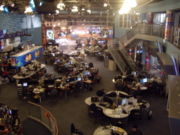Newsroom
From Wikipedia, the free encyclopedia
A newsroom is the place where journalists, either reporters, editors, producers and other staffers work to gather news to be published in a newspaper or magazine or broadcast on television, cable or radio. Some journalism organizations refer to the newsroom as the city room.
Contents[hide] |
[edit] Print publication newsrooms
In a print publication's newsroom, reporters sit at desks, gather information, and write articles or stories, in the past on typewriters, then after the early 1980s, on computers. These stories are submitted to editors, who usually sit together at one large desk, where the stories are reviewed and possibly rewritten. Reporters generally used the inverted pyramid method for writing their stories, although some of the best journalistic writing used other methods; some of the work of Tom Wolfe is an example of reporting that did not follow that style.
Once finished, editors write a headline for the story and lay it out (see publishing) on a newspaper or magazine page. Editors also review photographs, maps, charts or other graphics to be used with a story. At many newspapers, copy editors who review stories for publication work together at what is called a copy desk, supervised by a copy desk chief, night editor, or news editor. assignment editors, including the city editor, who supervise reporters' work, may or may not work with the copy desk.
How a newsroom is structured and functions depends in part on the size of the publication and when it is published, especially if it is a daily newspaper, which can either be published in the morning (an a.m. cycle) or the evening (a p.m. cycle). Most daily newspapers follow the a.m. cycle.
In almost all newspaper newsrooms, editors customarily meet daily with the chief editor to discuss which stories will be placed on the front page, section front pages, and other pages. This is commonly called a "budget meeting" due to the fact that the main topic of the meeting is the budgeting or allocation of space in the next issue.
Newsrooms often have an assignment desk where staffers monitor emergency scanners, answer telephone calls, faxes and e-mails from the public and reporters. The assignment desk is also responsible for assigning reporters to stories or deciding what is covered and what isn't. In many newsrooms, the assignment desk is raised a step or two above the rest of the newsroom, allowing staffers who work at the desk to see everyone in the newsroom.
[edit] Broadcast newsrooms
Broadcast newsrooms are very similar to newspaper newsrooms. The major difference is these newsrooms include small rooms to edit video or audio.
[edit] Misconceptions
The popular but dated conception of an American newsroom is a large room filled with desks, typewriters and teletype terminals, where many men and few women work loudly and furiously, reading their notes from reporters' notebooks, talking on the telephone, typing out their stories, arguing with each other, smoking and even drinking alcoholic beverages openly.
The denizens of an American newsroom are portrayed as hard-nosed, world-weary cynics with little sympathy for the subjects of their stories, although some are portrayed as caring people who developed thick skins as a reaction to having reported so many depressing stories. They also are portrayed as committed to telling the truth as they found it, no matter the cost. Some consider the ethic of journalism akin to a moral philosophy in how journalists struggle to live by its principles.
[edit] Changes in newsrooms
The modern American newsroom has gone through several changes in the last 50 years, with computers replacing typewriters and the Internet replacing teletype terminals, and more from ethnic minority groups as well as women are working as reporters and editors, including many managerial positions. Many newspapers have internet editions, and at some, reporters are required to meet tighter deadlines to have their stories posted on the newspaper website, even before the print edition is printed and circulated. However, some things haven't changed; many reporters still use reporter's notebooks and the telephone to gather information, although the computer has become another essential tool for reporting.
[edit] Newsrooms in popular culture
- The American newsroom has been a location of many books, movies and television shows about the newspaper and magazine business, especially movies like His Girl Friday, All the President's Men or The Paper, and television shows like Lou Grant and Murphy Brown.
- A Canadian newsroom is the location of the CBC Television comedy The Newsroom. It is also shown on some public television stations in the United States.
- The 2004 film Anchorman: The Legend of Ron Burgundy, is set around a newsroom.
[edit] Other uses
Newsroom is also the name of a Web site based in New Zealand which mostly supplies news to corporate intranets.
Newsroom was the name of a computer software program published by Springboard Software in the 1980s, considered to be among the first WYSIWYG desktop publishing programs for the Apple II personal computer.

